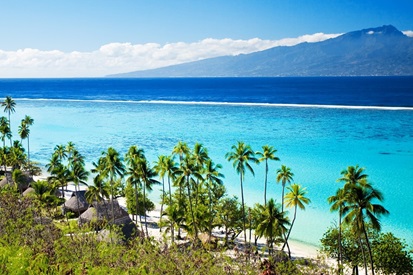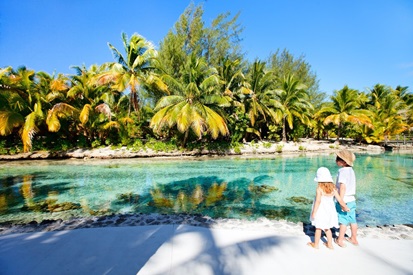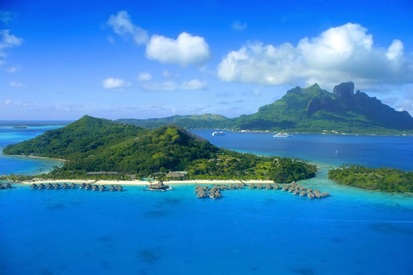

French Polynesia consists of five archipelagos located in the South Pacific Ocean. These are the Society Islands, including the Windward Islands (Tahiti) and the Leeward Islands, the Tuamotu Archipelago, the Gambier Islands and the Marquesas Islands. French Polynesia extends over a territory as vast as the European Union, but is home to only 260 thousand people... Of the 118 islands, only 67 are inhabited. The largest of these is Tahiti, where the capital of French Polynesia, Papeete, is located.
- Local time is GMT-10. The time difference with France is 11 hours in summer and 10 hours in winter. This is important to take into account when planning your trip.
- Major cities: Avatoru, Mataura, Papeete, Rikitea, Taiohae, Uturoa, Pirae, Faa.
- Population: 266’300
- Area: 4,167 km²
- Coastline length: 2,525 km
- Highest point: Mount Orohena, 2,241 m
- National holiday: Storming of the Bastille, July 14
- Official language: French
- Religion: Protestant and Catholic, Mormon minority
Tahiti is the largest island in the archipelago, located in the southern part of French Polynesia. This island is very touristy and there is a lot to see and do. Tahiti is a volcanic island, so there is a risk of eruption. If you are on the island during an eruption, follow the instructions of the local authorities.

Depositphotos
What you need to know before traveling to French Polynesia
- The status of an overseas territory of France allows Polynesia to guarantee a level of safety and quality of healthcare that meets Western standards. However, it is still better to take your medications with you.
- The average budget for a trip to French Polynesia is 3,000 euros per person for 10 days.
- The climate of Polynesia is tropical, warm all year round, but the maximum temperature is +33°.
- The accepted currency in most of French Polynesia is the US dollar and the euro. However, in Tahiti, the French Pacific franc (CFP) is accepted.
- The staff of local restaurants, hotels, shops and resorts speak fluent English, but the official languages of French Polynesia are Tahitian and French.
- Visa and air tickets. Visitors to French Polynesia do not need a tourist visa if their stay is less than 90 days. However, you will need a valid passport (valid for at least six months after arrival), confirmation of return or onward flight. There are local flights between the archipelagos, but book your tickets in advance.
- Modern transport allows you to get to all the islands quickly and comfortably.
- In summer, forest fires are common and can be dangerous.

Depositphotos
When to Visit the Polynesian Islands
June to September is considered the best time to visit French Polynesia because the weather is dry and the temperatures are not too high. Although this period is considered peak, you can still have a great holiday in the islands of French Polynesia.
Summer in French Polynesia (December to February)
Best for: Chinese New Year celebrations (festivals, parades, dances, etc.), 4x4 tours, and vanilla orchid viewing.
Although temperatures can exceed 30°C (86°F) and humidity levels are relatively high in French Polynesia during the summer, you can still enjoy the perfect island getaway in December, January, or February. Tropical storms are rare during the summer season, so you don’t have to worry about lightning or thunderstorms affecting your trip.
In January and February, French Polynesia comes alive with festivals, music, and dance to celebrate the Chinese New Year.

Depositphotos
Autumn in French Polynesia (March-May)
Best for: Ori Tahiti Festival, surfing and hiking.
If you want to avoid the hustle and bustle of peak season, then March, April and May are the best times to visit the islands. Not only will the prices for activities and accommodation be lower, but the islands will also be quieter. Luckily, the weather is still quite pleasant in autumn, with average temperatures around 25°C, but tropical downpours are quite possible. These downpours are usually short-lived.
The charming Ori Tahiti Festival is held in April and is a must-see. Go surfing, hike the many trails and enjoy the islands.

Depositphotos
Winter in French Polynesia (June-August)
Best for: diving, snorkeling and exploring the jungles of the islands.
With warm temperatures (not too hot) and little rain, these months are considered the best for travel. However, this will also mean higher prices and more travelers. This season is the best for exploring the islands' extensive marine life.

Depositphotos
Spring in French Polynesia (September-November)
Best for watching humpback whales and dolphins, visiting fruit plantations and pearl farms, and taking a sunset cruise.
While winter is considered the best season for travel, September is actually the best month to visit French Polynesia. This is because September is the driest month with the least rainfall and the longest days. However, prices will be higher and there will be more people.

Depositphotos
Cost of a holiday in Polynesia
The budget for a trip to French Polynesia varies depending on the length of your stay, the type of transport you choose and the activities you want to do. Diving, surfing or kitesurfing will be quite expensive.
- Accommodation (2-3 star hotel) per night/person – 80 euros
- Accommodation (5 star hotel) per night/person – 500 euros
- Hostel – from 30 euros
- A boat trip from Tahiti to Moorea costs about 20 euros
- A trip to a nearby island (Leeward Islands or Tuamotu): from 250 to 300 euros
- Kayak rental for half a day: 16 euros
- One dive: 60 euros
- A day on a boat in the lagoon: from 50 to 80 euros depending on the island
- Whale watching tour: 65 euros
- A day trip to Tetiaroa Atoll: 100 euros
- A day trip by SUV to Papenoo Valley: 60 euros
- Jet ski: 1 hour – 125 euros, 3 hours – 185 euros (per jet ski)
- Trip Quad bike: 2 hours 30 minutes, 120 euros
- Surfing lessons: 35 euros for 2 hours, 160 euros for 5 lessons, 210 euros for 10 lessons
- Street food: 4-6 euros
- Set meal in a restaurant: from 40 euros
- Car rental for one day: in Tahiti 35 euros, and on other islands from 40-50 euros
- Scooter rental for one day: 25 euros
- Bike rental for one day: 8 euros
- Bus ticket in Tahiti: from 1.5 to 5 euros depending on the distance
- Taxi ride: from the center of Papeete to the airport: 15-20 euros
On average, a two-week trip per person with a flight:
- Economy option: 2500 euros
- Average budget: 7900 euros
- Unlimited budget: 18500 euros

Depositphotos
French Polynesia Holidays
- January: Tahiti hosts the Oceania International Documentary Film Festival.
- January-February: Tahiti, Chinese New Year with processions and ceremonies.
- February: Moorea, Moorea Marathon.
- March: Raiatea, Tahiti International Fishing Tournament (big game fishing). In the Marquesas Islands, the Marquesas Islands Mini Festival.
- April-May: Tahiti Nui Von Zipper Trial (surfing: Pro round qualifier) and Tahiti Billabong Pro (international surfing competition in Teahupoo).
- May: Moorea, Moorea Raid (kayak, mountain bike, mountain race). In the Leeward Islands, the Tahiti Pearl Regatta (departure from Raiatea). In the Astral Islands, the Me ceremony (Evangelical Church ceremony).
- July: Tahiti, International Golf Open.
- August-September: Leeward Islands, Tahiti Nui Cup (departs Raiatea). Tahiti, Taapuna Master/Taapuna Pro (surfing competition in Punaauia). Moorea, Raid Painapo.
- October: Leeward Islands, Hawaii Nui Vaa (canoe race). Moorea, Tour du Rotui. Tahiti Carnival throughout the month.
- December: Moorea, Rotui Green Triathlon (swimming, kayaking, running). Marquesas Islands, Marquesas Festival.

Depositphotos
Archipelagos and islands of French Polynesia
As we have already mentioned, Polynesia has 5 archipelagos, but not all of the islands are popular with tourists.
Society Archipelago
The most populous Society Archipelago consists of 14 islands (9 high islands, 5 atolls), divided into the Windward Islands (Tahiti, Moorea, Tetiaroa) and the Leeward Islands (Huahine, Raiatea, Taha'a, Bora Bora, Maupiti).
Between the lagoons and mountains, you can do many water and land sports, and try the Polynesian culture.

Depositphotos
Tahiti Holidays
Tahiti is the largest island in the archipelago. The main island of French Polynesia, where the spontaneous and genuine friendliness of the Tahitians captivates travelers, offers a wealth of natural sites to explore. The lush Papenoo Valley, which can be explored by 4x4, the black sand beaches of the east coast, and the legendary surf spot Teahupoo are all must-sees. Discover the metropolis of Tahiti, the colors and aromas of the colorful market, visit the Pearl Museum, stroll through the evening square of Vaiete, taste the best Tahitian raw fish…
Papeete is the beautiful capital of Tahiti. It is an elegant city where flowers and palm trees grow in abundance. Once a trading and whaling port, today it has become a tourist paradise. The Robert Wang Black Pearl Museum chronicles the history of the rare Tahitian black pearl, which is an integral part of the island's history. The 19th century Notre Dame Cathedral is the oldest in Tahiti, and a visit to this charming building with its beautiful tall spire and red roof is a must!

Depositphotos
Moorea - Tahiti's Sister Island
This gem of an island surprises with contrasts between green, jagged reliefs, white sand beaches and turquoise lagoons. Moorea is an island paradise with white sand beaches and turquoise lagoons. Animal and flora lovers make a long stop here for diving at Tamoana Pass or for open-air snorkeling. Majestic stingrays, playful dolphins, humpback whales, sharks and small colorful fish are encountered during boat trips.
On Moorea Island, you can enjoy breathtaking 360-degree views of the lagoon, ocean and surrounding paradise island. The route also allows visitors to see valleys, villages, orchards and pineapple farms. This ancient volcanic island is best reached by 4WD or ATV.
The Belvedere viewpoint offers stunning views of Cook Bay, the Opunohu Valley, Mount Rotui, its slopes and peaks. The Arahoho blowhole is a popular local landmark that can be seen from the roadside. The Aremiti ferry operates between Tahiti and Moorea and departs from Papeete.

Depositphotos
Raiatea, the sacred island
The Polynesian expansion in the Pacific Ocean began with this island, nicknamed the cradle of the gods, or more precisely with the sacred marae of Taputapuatea, listed as a UNESCO World Heritage Site. A stay in Raiatea will take you to the Faaroa River, which you can reach by boat or kayak. Take a hike to discover three waterfalls, Mount Temehani. You can spend a day on a boat on the twin island of Tahaa.

Depositphotos
Bora Bora, the pearl of the Pacific Ocean
Here is one of the most beautiful lagoons, if not the most beautiful in the world. The gradation of shades of blue is stunning! The island is home to the best hotels in the archipelago. Most of the activities are related to the sea: diving with the possibility of observing stingrays, dolphins, Napoleons, reef sharks and whales.
Vaitape is the largest town in Bora Bora, famous for Matira Beach, the largest public beach in the region. Motu Piti Aau is a small but stunning island off Vaitape, part of the cruise program. Stay for two on the stilts of a Bora Bora water villa, relax on the terrace and dive into the most beautiful lagoon in the world from a private pontoon. Stroll around the island and discover the famous American cannons from World War II.

Depositphotos
Tuamotu Archipelago
An archipelago of 78 atolls, the main ones are about an hour's drive from Tahiti. An atoll is a strip of volcanic and coral land formed by the collapse of a crater. These strips of land, ranging from a few dozen to a few hundred meters wide, form a ring surrounding a lagoon. The largest of them, such as Rangiroa, Fakarava, Tikehau or Manihi, stretch for tens of kilometers (80 by 35 km for Rangiroa, the largest).
The atolls are the ideal starting point for exciting ocean dives. Rangiroa offers exceptional dives in the Avatoru and Tiputa passes. It is the second largest atoll in the world with an endless sky: an aquarium! This island is home to a pearl farm, a vineyard and the fabulous Blue Lagoon.

Depositphotos
Marquesas Islands
1500 km north of Tahiti, 12 islands (11 high islands and 1 atoll) join together to form the Marquesas Archipelago. They have no coral reefs: dizzying peaks drop straight into the ocean. These islands have attracted the greatest artists (Brel, Gauguin). You will discover the magnificent valleys of Nuku Hiva and Hiva Oa, traveling by 4x4, on horseback or on foot.
Hiva Oa is the pearl of the Marquesas Islands. An untouched corner in the heart of the wild nature. Atuona also has an interesting craft center. You can ride horses through its secret valleys or dive with mantas. You will get to know the Marae - a sacred monument and place of worship for the locals. Tikis are human-shaped figures made of basalt stone or wood, often representing good or evil spirits and used in witchcraft for protection. In the Marquesas Islands, you will see petroglyphs carved into the rock, the true meaning of which remains a mystery to mankind.

Depositphotos
Austral Archipelago
600 km south of Tahiti lies the Austral Archipelago, consisting of 6 high islands and an atoll that offer a more temperate climate. Stops at Rurutu, Tubuai or Raivai are a true paradise on earth, ideal for whale watching, kitesurfing, meeting locals and relaxing.
Gambier Islands
Located in the extreme southeast of Polynesia, Gambier is far from the main tourist routes, so there are few tourists.

tahititourisme.com
What to do in French Polynesia
The choice of leisure activities is huge. Excursions to the lagoons, scuba diving or snorkeling, dance shows, excursions by 4x4, quad bike, walking or horseback, swimming with dolphins, sharks or rays, diving in waterfalls, catamaran rides, whale watching, surfing initiation, buying Tahitian pearls or local handicrafts, visiting Polynesian temples…
- Polynesia is an ideal place for diving. You will have the opportunity to see the whale migration from August to October or explore shipwrecks. However, on these islands you are warned in advance: the ocean is not a zoo, we cannot guarantee the absence of predators. Indeed, it is impossible to leave Polynesia without seeing a shark. From May to October is the best time for scuba diving and the best beach weather. Diving in the Tuamotu archipelago is ideal for observing marine life. Fakarava Atoll is one of the most famous and popular diving sites in the archipelago. Secluded bays and beaches are another reason to visit this region.
- Combine the main trio of Tahiti-Moorea-Bora Bora with more secluded islands to discover the real Polynesia: Maupiti, Tikehau, Fakarava, Huahine. Follow in the footsteps of Gauguin and Brel in Hiva Oa, who crossed the world to find themselves in this wild paradise at the end of the world.
- Try the famous banana jam, visit a vanilla plantation, a pearl farm and immerse yourself in a coral garden in Taha'a.
- Relax in a majestic spa with a Polynesian massage surrounded by exoticism and tropical fruits.
- Take part in a mission to observe and preserve bottlenose dolphins in the Tuamotu with naturalists and scientists from the CETA'BIOSPHERE program.
- Travel around the islands. Transportation in Polynesia is unique. You can choose between boats and planes. On the islands themselves, tourists can rent a car, use a taxi, or, for a more colorful experience, use public transport.
- Get a tattoo. Polynesians are very fond of tattoos. The art of tattooing originated about 1,500 years ago in the Marquesas Islands. The word tattoo itself comes from Tahiti. According to legend, the god Tatau was the creator of all ocean fish, flowers and patterns. It is with these patterns that the famous tattoos of the inhabitants of French Polynesia are associated. The sailors of the legendary captain Cook became acquainted with these patterns during the expedition and got tattoos before returning to Europe. Since then, the tattoo of the inhabitants of French Polynesia has become popular in the world.

Depositphotos
What you need to know about the local cuisine
The cuisine of the islands consists of very tasty, colorful, but light dishes. Locals prefer to eat raw food to preserve useful minerals and nutrients.
Cooking any dish in a Tahitian oven gives the food a special taste. Food is cooked in a pit covered with wood, dried coconut and volcanic stones.
There is a lot of seafood here, which is prepared in a way that is unusual for the rest of the world: for example, fafaru - a national dish in which a fish bone (tuna) is fermented in a calabash filled with sea water.
In Polynesia, you can taste giant clams, and all fish is usually eaten raw and with coconut milk. For example, among the dishes of French Polynesia, you can note raw fish with lime juice and coconut milk.
You will also find many French pastries, for example, with caramel or coconut cream. Traditional pudding was made from banana and starch, flavored with vanilla and coconut milk. By the way, vanilla in Polynesia is different from the usual one. Here it is made from orchids and is called black gold.

Depositphotos
Polynesians are warm, open and generous people. They are blessed with kindness and will welcome you with open arms, with a tiara flower necklace around their neck. You will experience this hospitality when shopping in the markets, especially those of Papeete, the capital of French Polynesia. It is considered one of the most colorful in the world.
Polynesia remains relatively untouched by mass tourism. Only about 200,000 tourists set foot on these shores each year. Come to this slice of paradise - book your holiday!
More articles
- Port Louis: All About Mauritius' Capital
- Seychelles Honeymoon Hotels: 9 Paradise Spots
- Bali's Best Eco-Hotels: Top 12 Spots
- Seychelles for outdoor activities - from diving to jungle trekking
- Why you can be deported from Bali - several main reasons
- Seychelles hotels with the best panoramic views
- UNESCO sites in Indonesia: temples, parks and other amazing places
- Yogyakarta - all about the historic city of Java
- St. Anne Island in the Seychelles
- When to fly to Seychelles: prices and weather



